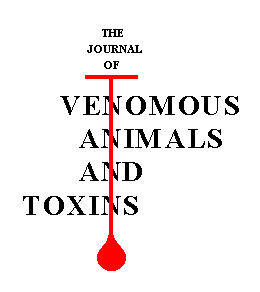Resumo em Inglês:
Toad envenoming in dogs can cause death by cardiac fibrilation (CVF). Traditional therapy consists mainly of atropine and propranolol, the last one used to prevent the CVF, that is preceded by negative ventricular deflections (NVDs) in the QRS complex of the electrocardiogram. This study intended to verify, comparatively, the lidocaine, propranolol, amiodarone, and verapamil abilities to prevent CVF in experimentally envenomed dogs. Thirty-six dogs were divided into 6 groups (GL, GP, GA, GV, GST, and GSV) with n=6; the dogs were submitted to volatile anaesthesia. The animals of the groups GL, GP, GA, and GV received 0.38g of toad venom through oro-gastric catheter and were treated with the following drugs respectively: lidocaine (4mg/Kg), propranolol (0.1mg/Kg), amiodarone (8mg/Kg), and verapamil (2mg/Kg). These drugs were repeated if NVDs reappeared with cardiac frequency >150, GST was not treated and GSV was just anaesthetized. The following results were obtained: GL, NVDs present in 4 animals, 100% recuperation with 3.66 doses/animal; GP, NVDs present in 2 animals, 100% recuperation with 1.66 dose/animal, with bradycardia at the anaesthetic return; GA, NVDs present in 3 animals, 33.33% recuperation with 1.5 dose/animal; GV, NVDs present in 4 animals, 100% recuperation with 2.16 doses/animal; GST, NVD present in 6 animals, 100% death and GSV, NVDs absent, 100% recuperation. As a conclusion, the anaesthetic proceedings used, did not cause NVDs, the envenoming that was not treated was lethal, and among the antiarrhythmics drugs used, verapamil was the most efficient, as it did not cause any serious bradycardia at the anaesthetic return and did not require repeated administrations. For lidocaine, it was efficient but required various administrations; amiodarone could not prevent the death of 4 animals; propranolol was efficient in relation to NVDs control, but caused serious bradycardia at the anaesthetic return.
